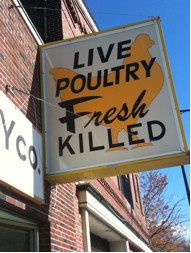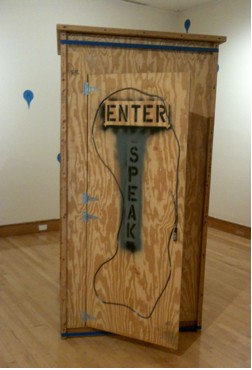Fuse Review — ROUND: Cambridge Sounds the Depths of the City’s Public Art
ROUND: Cambridge is a testament to what can be accomplished using smart phones, GPS coordinates, and a Google map.
By Margaret Weigel.

ROUNDmap — on display at the CAC gallery in Cambridge, MA (344 Broadway) until November 23rd. Photo: Margaret Weigel.
If you needed proof of our growing attachment to our technological gadgets, a recent study found that 38% of men were willing to make a “significant sacrifice” if they could get an iPhone 5 without the hassle of waiting in line. Art has kept pace as our culture is increasingly propelled by digital apps and portable hardware and the love/hate relationship they frequently engender.
The sound artist Halsey Burgund, following on the success of his site-specific installation at the deCordova Museum in 2010, partnered with the Cambridge Arts Council to produce ROUND: Cambridge, a “public art app” that allows users to submit audio from any Cambridge location. The comments, submitted from a smartphone running the (free) ROUND app, can be heard by location on a GoogleMap or as a more random audio mashup of collected comments through the phone app. The Cambridge version received a thumbs-up from Wired magazine, the gospel for all things techie.
ROUND: Cambridge is a testament to what can be accomplished using smart phones, GPS coordinates, and a Google map. The stated goals of the project are twofold: to both explore Cambridge’s ample if often overlooked public art works and capture viewer commentary; the phone app allows users to listen to comments left by previous visitors or to submit his own thoughts. Burgund relies on the language of graffiti, referring to comments as a way to “tag” a location with a snippet of audio. But unlike traditional graffiti, these tags are not visual, not permanent, and not violating anyone’s property rights.
Despite this minor aggravation, the ROUND project succeeds well beyond its stated mission. One of the hazards of public art is that neighborhood residents tend to grow accustomed to them and, over time, they fade into the landscape. The app counteracts that tendency by both identifying works and encouraging direct viewings—Cambridge’s own exotica, rediscovered by intrepid urban explorers. At the very least, the app encourages viewers to pay closer attention to their surroundings by, ironically, interacting with a cell phone. The app is designed to only work within Cambridge’s borders (I checked) and recorded comments typically range from the thoughtful (“My friend and I would talk about how you can’t really get a wrong answer, or a really right answer in the humanities, but there’s always a right and wrong answer in math, which is really quite poetic when you think about it”) to the snarky (“I’m standing here in front of the Irish Famine Memorial . . . it’s reminding me that I’m actually pretty hungry.”)
One of the beautiful and unexpected aspects of this project is what might be called “asynchronous collective art critiquing.” We typically rely on museums and galleries to set the bar for what constitutes good art, but public art plays by a different set of rules: the best public art is apolitical, accessible to a wide audience, durable, collectively financed—and owned. With public art, everyone’s a critic, and many of the ROUND comments I listened to were generalized art critiques: “I think the bronze works well here . . . if they’d placed the cats closer together they wouldn’t have had room for plants,” said one commenter on the feline benches next to the King Open school. Another liked the mural on the school’s face but wishes it had been rendered in, oh, marble. And so it goes. Opinions about public art are usually limited to a thought or a quick aside to a friend: the ROUND app implicitly functions as a forum for critiquing public works by a large number of viewers. It would be great to learn if commenters are directly responding to previous tags and also to aggregate these public comments to inform future art commissions.
Speaking of future public art, there is a delightful red herring in the app that allows the user to input anything within Cambridge as a “site you think should be considered public art.” So I traveled along Cambridge Street to my old ‘hood to the visual icon for residents, visitors, and lost cabdrivers in perpetuity: The 6’ yellow “Live Chickens/Fresh Killed” sign outside Mayflower Poultry on Cambridge at Eighth Street. The sign went missing for a few weeks in the nineties; we felt we’d lost our North Star. I launched the ROUND app, identified myself as a “girl” and spoke of my love for the sign and how I used to be able to look out my apartment window at it glowing at night. I no longer live in Cambridge, but I started thinking about my time there, what constitutes home, and how these icons burn into our collective memories.
Cambridge’s public art holdings stretch across more dozens of miles, and to visit them all would test the mettle of even the most diehard public art fan. At the CAC exhibit, on display at the CAC gallery (344 Broadway) until November 23rd, one can survey and listen to all of the audio submissions in the comfort and privacy of a tricked-out plywood booth in the center of the room.
The user can see, via a Google Map on a computer screen, where submissions were made. Clicking on just one audio submission from a cluster can be a challenge; the computer touch screen required targeted, aggressive pokes to successfully launch an audio clip.
While the CAC gallery exhibit closes around Thanksgiving, the project will continue through 2014. I highly recommend downloading the app and strolling around Cambridge, listening to a mix of voices share their thoughts about what strikes them as they move through the city. Go here for more information about the project.
Tagged: Halsey Burgund, ROUND: Cambridge, site-specific installation


